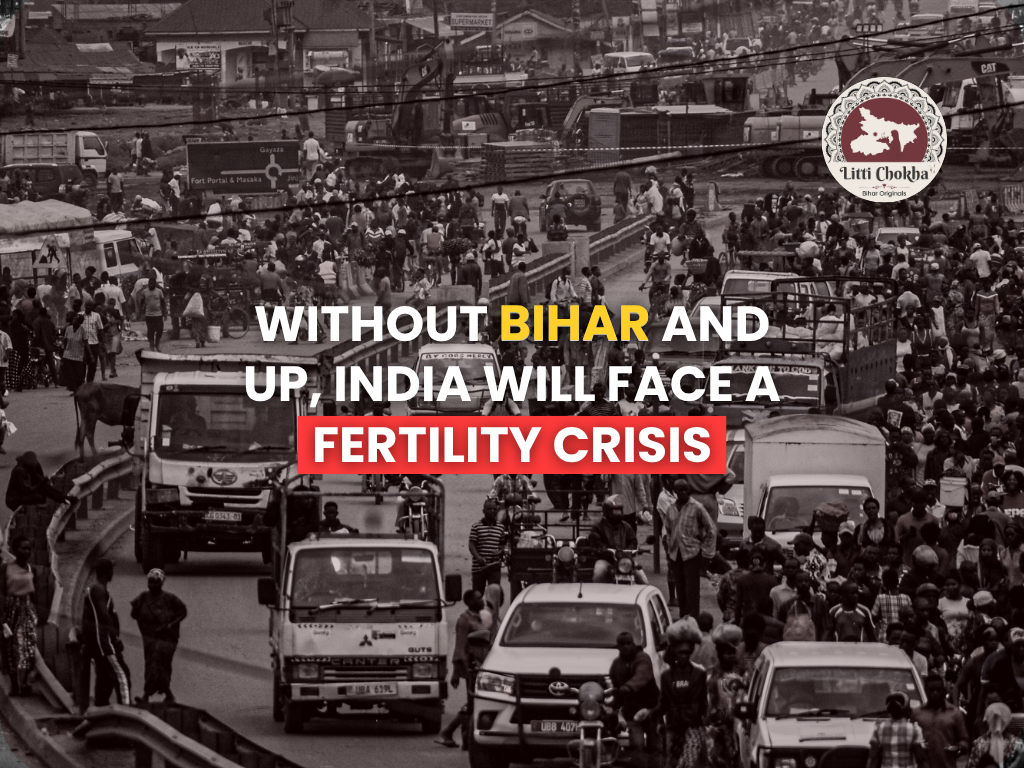Without Bihar and UP, India’s Population Would Be in Free Fall

India has been considered as a country with an exploding population but the recent trends indicate the opposite. Now, there is a stark decline in the fertility rates of Indian states. The total fertility rate (TFR), according to the United Nations Population Fund’s 2025 report, has dropped to 1.9. This is lower than the recommended 2.1 that’s needed to maintain a stable population.
According to Sanjeev Sanyal, a member of the Economic Advisory Council to the Prime Minister, this change is not just limited to the southern or urban states now. He says, without Bihar and Uttar Pradesh, the national average will drop even lower. These states are still having relatively sustainable fertility rates.
In this article, we’ve explained how Bihar and Uttar Pradesh are maintaining India’s falling fertility rate, why this matters for the country’s future, and how it connects to population trends seen in countries like Japan and China.
Table of Contents
Bihar and UP Slowing The Fertility Crash

Bihar and Uttar Pradesh have long been infamous for being overpopulated and a strict need for family planning measures is suggested there. However, they are now playing a stabilizing role in India’s demographic equation. Both states still record fertility rates above the national average. But, they too are gradually declining.
As per the data from the National Family Health Survey (NFHS-5), Bihar’s TFR is 2.98 and Uttar Pradesh’s is 2.35. These two states are acting as demographic buffers against the rapid drop seen in states like Kerala (1.8), Tamil Nadu (1.6), and Himachal Pradesh (1.7).
Births Peaked 15 Years Ago
According to demographic projections, India reached its highest annual births around 2008. Since then, the annual birth rate has been steadily declining each year.
This decline is actually visible in school enrollment figures, especially in the southern and northeastern states of India. This decline has forced the closure or merger of schools. The Ministry of Education’s UDISE+ data shows a consistent fall in enrollment in early education levels in many districts.
Demographic Transition Zone is Approaching

According to Sanjeev Sanyal, India is heading towards a condition that is similar to countries like China, Japan, and South Korea which is known as demographic transition zone. The countries in this zone are now struggling economically due to shrinking workforces, older populations, and increasing pressure on welfare systems.
India is known in the world for having the youngest population which is boom for a country’s economy growth. But these predictions about India heading towards the demographic transition zone is very concerning. As we have seen China had a fertility rate of 1.2 in 2022 after which it’s population started shrinking in 2023. South Korea has the world’s lowest fertility rate that was recorded as 0.72 in 2023. Similar trends have been seen in Japan as it has the world’s oldest population globally. This adds to the challenge of decreasing labour supply and increased pension systems.
Southern States’ Pronatal Policies
Due to these concerning trends indicating the drop in fertility rate, some South-Indian states like Tamil Nadu and Kerala, have discussed a out offering incentives for childbirth, tax rebates, and expanded childcare support. Policymakers are working on reversing this trend by such pro-natal policies.
On the other hand, India is still operating “population control departments” in almost every state including Bihar and UP. Now there’s no need of such systems as they were set up in the 1970s and 1980s during the peak of population anxiety.
Need to Shift Policy Priorities
Sanjeev Sayal has argued that population control measures are counterproductive in the current context. The real concern is not managing excessive population but the decline in younger population. Some other experts in demography have also raised similar concerns. Otherwise even India may suffer with workforce shortage.
According to World Bank estimates, India’s median age is expected to rise from 28.4 in 2021 to 38.1 by 2050. The share of the population aged 60 and above will increase from 10% in 2021 to over 20% by mid-century.
Conclusion
In this context, Bihar and Uttar Pradesh are no longer demographic burdens, rather they are demographic cushions. Their younger populations, must be provided with proper education, health infrastructure, and employment opportunities so that can become the backbone of India’s economic growth in the coming decades.
Just as bizarre policies like Freight Equalisation crushed Bihar’s economy, today’s fertility trends highlight how Bihar is again gaining importance in India’s sustainability, but still it is overlooked.
I’m Shakti Bhardwaj, a second-year Law student with a deep interest in current affairs, international relations, politics, and everyday news. My passion for staying informed and analyzing key developments drives me to write part-time for LittiChokha News & Media Company, where I aim to share reliable and insightful content with readers.





